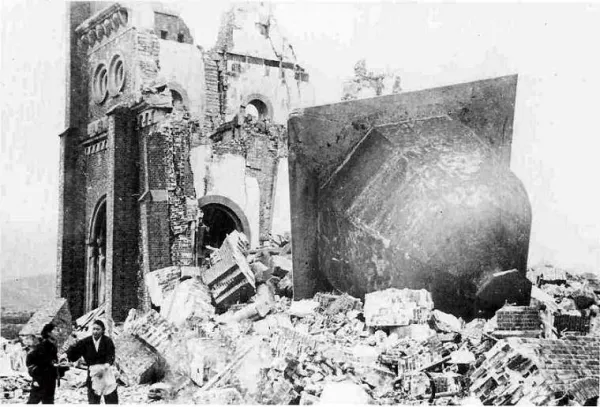
CNA Staff, Jul 13, 2020 / 07:19 pm (CNA).- For the upcoming anniversary of the detonation of two atomic bombs on Japan, the US bishops have encouraged Catholics to pray for peace alongside the Church in Japan.
Issued by the USCCB’s Committee for International Justice and Peace, a statement was released July 13, a few weeks ahead of the 75th anniversary of the bombings of Hiroshima and Nagasaki.
“August 6 and 9 mark the 75th anniversary of the bombings of Hiroshima and Nagasaki, the first, and one hopes the last, times that atomic weapons are employed in war,” the bishops said.
“The 21st century continues to witness geopolitical conflicts with state and non-state actors, increasingly sophisticated weapons, and the erosion of international arms control frameworks. The bishops of the United States steadfastly renew the urgent call to make progress on the disarmament of nuclear weapons.”
Since St. John Paul II visited Japan in 1981, the Catholic Church in Japan has observed Ten Days of Prayer for Peace beginning Aug. 6. For the 75th anniversary, the USCCB has encouraged Catholics in the United States to join Japan in prayer by offering intentions of peace at Mass Aug. 9.
“The Church in the U.S. proclaims her clarion call and humble prayer for peace in our world which is God’s gift through the salvific sacrifice of Christ Jesus,” they said.
The only wartime use of nuclear weapons took place in 1945's Aug. 6 attack on Hiroshima and Aug. 9 attack on Nagasaki by the United States.
The Hiroshima attack killed around 80,000 people instantly and may have caused about 130,000 deaths, mostly civilians. The attack on Nagasaki instantly killed about 40,000, and destroyed a third of the city.
Pope Francis visited Nagasaki and Hiroshima in November 2019. There, he spoke against nuclear arms and promoted international harmony, noting that peace will not be ensured by a threat of nuclear war.
“A world of peace, free from nuclear weapons, is the aspiration of millions of men and women everywhere,” he said. “Our response to the threat of nuclear weapons must be joint and concerted, inspired by the arduous yet constant effort to build mutual trust and thus surmount the current climate of distrust.”
In February, Pope Francis once again spoke against nuclear arms and the Committee of International Justice and Peace reemphasized the Pope’s position. They said fear is not a stable enough platform to sustain peace.
“Recently, we, the bishops of the USCCB’s Committee on International Justice and Peace re-affirmed the Holy Father’s call to ‘renewed effort to bring about a world of peace and justice that is not based upon fear or the threat of nuclear annihilation but justice and human solidarity.’”
“Fear, distrust, and conflict must be supplanted by our joint commitment, by faith and in prayer, that peace and justice reign now and forever.”
If you value the news and views Catholic World Report provides, please consider donating to support our efforts. Your contribution will help us continue to make CWR available to all readers worldwide for free, without a subscription. Thank you for your generosity!
Click here for more information on donating to CWR. Click here to sign up for our newsletter.



In the days ahead we can expect to see more on the issue of armaments and morality. Here’s a look back, and a related hint about future “synodality”:
In 1983 three national Episcopal conferences produced non-doctrinal pastoral letters (not yet “binding synodal paths”!) on nuclear weapons. Major DIFFERENCES were on the nature and framing of the threat itself, and then (1) the risk of collateral damage or the “slippery slope” to Armageddon and “nuclear winter” (the American), (2) the strategic imbalance of armaments on the eastern front with the Soviets hold a decisive 3:1 advantage in mobile tanks (the German), or (3) the intrinsic threat of Marxist ideology (the French).
PRIOR TO all three of these pastorals, in 1982, Pope John Paul II had clarified the Church’s prudential judgment (no loose-end “binding synodal paths” in a Polygon Church) to the Second Special Session of the United Nations dedicated to disarmament. One KEY LINE: “In current conditions ‘deterrence’ based on balance, certainly not as an end in itself but as a step on the way toward a progressive disarmament, may still be judged morally acceptable” (p. 10).
THREE QUESTIONS, as we approach the 75th anniversary of the Hiroshima and Nagasaki holocausts:
(1) Will the challenging DISTINCTION between the possession and the actual use of nuclear weapons be respected (under new and complicating conditions: proliferation of nuclear and rogue states, tactical-level weapons and high precision targeting compared to 1945, and the merit or not of a “defensive” space shield)?
(2) Will continued and troublesome deterrence/balance be prudentially scrutinized OR ambiguously BRANDED as, say, “inadmissible”? Instead, are there astute ways that the Church might help foster “progressive disarmament”?
(3) And—within the Church—will the SUPPOSEDLY PATH-BREAKING SYNOD on “The Church and Synodality” (2022) find clues from the (above) real-world case study already on the books?
(See (a) “The Challenge to Peace” [Pastoral Letter of the United States National Conference of Catholic Bishops, 1983]; and in one-volume (b) James Schall, S.J.: “Out of Justice, Peace” [Joint Pastoral Letter of the West German Bishops], and “Winning the Peace” [Joint Pastoral Letter of the French Bishops] [Ignatius Press, 1984]; and (c) Pope John Paul II, “Negotiation: The Only Realistic Solution to the Continuing Threat of War” [Boston: St. Paul Editions, 1982]).